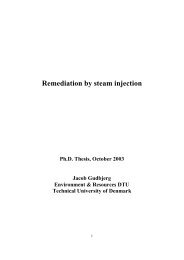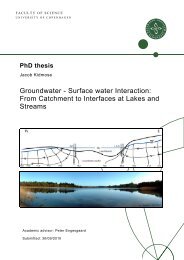Groundwater arsenic in the Red River delta, Vietnam ... - Fiva
Groundwater arsenic in the Red River delta, Vietnam ... - Fiva
Groundwater arsenic in the Red River delta, Vietnam ... - Fiva
Create successful ePaper yourself
Turn your PDF publications into a flip-book with our unique Google optimized e-Paper software.
4 Household sand filtration <strong>in</strong> <strong>the</strong> <strong>Red</strong> <strong>River</strong> <strong>delta</strong><br />
Many water treatment facilities worldwide apply aeration and sand filtration by<br />
which dissolved iron is removed from <strong>the</strong> raw water. This treatment also removes<br />
As which sorbs to <strong>the</strong> ferrihydrite formed by <strong>the</strong> oxidation of Fe(II) after <strong>the</strong><br />
aeration (Carlson and Schwertmann, 1987; Jessen et al., 2005). The removal<br />
process hence utilizes <strong>the</strong> common co-occurrence of ferrous iron with As <strong>in</strong> <strong>the</strong><br />
contam<strong>in</strong>ated groundwater. The most important parameter for <strong>the</strong> efficiency of<br />
<strong>the</strong> removal process is <strong>the</strong>refore <strong>the</strong> ratio of dissolved iron-to-As <strong>in</strong> <strong>the</strong> raw water<br />
(McNeill and Edwards, 1997; Berg et al., 2006; Hug et al., 2008). The sorption<br />
aff<strong>in</strong>ity of As for ferrihydrite <strong>in</strong> natural waters depends on <strong>the</strong> As oxidation state<br />
(III or V), and As(III)-oxidation is <strong>the</strong>refore an important part of <strong>the</strong> treatment<br />
(Meng et al., 2002; Roberts et al., 2004; Jessen et al., 2005; Hug et al., 2008). In<br />
addition, solutes compet<strong>in</strong>g for sorption sites on <strong>the</strong> ferrihydrite surface,<br />
especially phosphate, may decrease <strong>the</strong> removal efficiency (Wilkie and Her<strong>in</strong>g,<br />
1996; Her<strong>in</strong>g et al., 1997; Meng et al., 2000, 2002; Dixit and Her<strong>in</strong>g, 2003; Berg<br />
et al., 2006; Hug et al., 2008).<br />
Despite a similar geographical and geological sett<strong>in</strong>g, <strong>the</strong> As-affected South East<br />
Asian <strong>delta</strong>s have important differences <strong>in</strong> <strong>the</strong> groundwater Fe/As ratio and<br />
phosphate concentrations, as shown by Hug et al. (2008). This <strong>in</strong> turn affects <strong>the</strong><br />
As removal efficiency of aeration and sand filtration. Generally, <strong>the</strong> groundwater<br />
<strong>in</strong> <strong>the</strong> <strong>Red</strong> <strong>River</strong> <strong>delta</strong> has both a high Fe/As molar ratio and a low concentration<br />
of phosphate relative to <strong>the</strong> Bengal and <strong>the</strong> Mekong <strong>delta</strong>s (Hug et al., 2008).<br />
Hence, generally, a higher As removal efficiency by sand filtration is expected <strong>in</strong><br />
<strong>the</strong> <strong>Red</strong> <strong>River</strong> <strong>delta</strong>, relative to <strong>the</strong> o<strong>the</strong>r <strong>delta</strong>s.<br />
Many private tube well owners <strong>in</strong> rural areas of <strong>the</strong> <strong>Red</strong> <strong>River</strong> <strong>delta</strong> have built<br />
aeration and sand filtration units to remove <strong>the</strong> iron and its metallic taste (IET<br />
and VAST, 2004; Berg et al. 2006; Hug et al., 2008). Interest<strong>in</strong>gly, Berg et al.<br />
(2006) showed that As concentrations after treatment were below 50 μg/L <strong>in</strong><br />
90% of <strong>the</strong> studied sand filters, and 40% were below <strong>the</strong> 10 μg/L WHO<br />
guidel<strong>in</strong>e. One of <strong>the</strong> advantages of <strong>the</strong> treatment method is that no oxidants or<br />
o<strong>the</strong>r chemical additive is required. In addition, <strong>the</strong> knowledge of <strong>the</strong> sand filter<br />
construction and ma<strong>in</strong>tenance is shared among people. These results <strong>in</strong>dicate a<br />
large potential of sand filtration for mitigation of <strong>the</strong> As problem <strong>in</strong> rural areas of<br />
21





